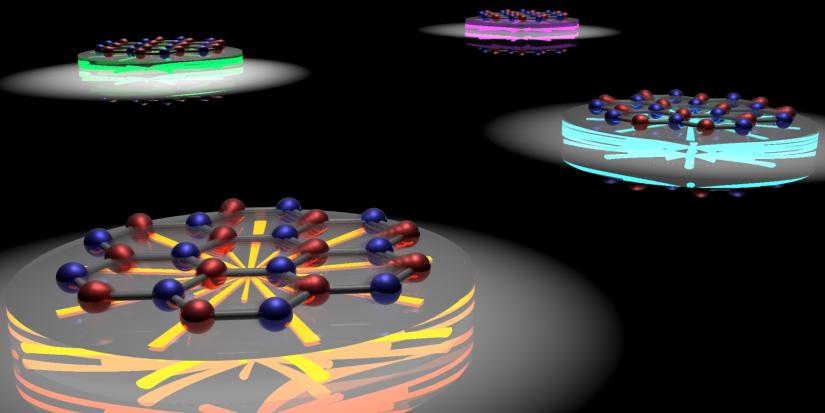Stretchable sheets of atoms tuned for quantum technologies

An artist impression showing the evolution of quantum light color when the atomically thin material is stretched. Image credit to Dr. Trong Toan Tran, one of the senior authors of the work.
A team of scientists from the University of Technology Sydney (UTS) and the Australian National University (ANU) believe they have developed a way to address a decades-long challenge in the field of quantum materials – the spectral tuning of proposed quantum light sources.
The researchers say their results, using an atomically thin material, hexagonal boron nitride, constitute a significant step forward in understanding light–matter interactions of quantum systems in 2D materials, and the journey towards scalable on-chip devices for quantum technologies. The study is published in the journal Advanced Materials.
The ability to finely tune the colours of quantum light has been proposed as a key step in developing quantum network architectures, where photons, the fundamental building block of light, are exploited to serve as the quantum messenger to communicate between distant sites.
The scientists harnessed the extreme stretchability of hexagonal boron nitride, also known as “white graphene” to such an extent that they were able to demonstrate a world record for the largest spectral, colour-tuning range from an atomically thin quantum system.
Lead author, UTS PhD candidate Noah Mendelson said that the improvement in spectral tuning by almost an order of magnitude would spark interest within both academic and industrial groups “working towards the development of quantum networks and related quantum technologies.”
“This material was grown in the lab at UTS with some atomic-scale ‘crystal-mistakes’ that are ultra-bright and extremely stable quantum sources.
“By stretching the atomically-thin material to induce mechanical expansion of the quantum source, this, in turn resulted in the dramatic tuning range of the colours emitted by the quantum light source,” he said.
“As the hexagonal boron nitride was stretched to only a few atomic layers thick the emitted light started to change colour from orange to red much like the LED lights on a Christmas tree, but in the quantum realm,” says Mendelson, from the UTS Faculty of Science School of Mathematics and Physical Sciences.
Seeing such colour-tuning at the quantum level is not just an amazing feat from a fundamental point of view, but it also sheds light on many potential applications in the field of quantum science and quantum engineering, he adds.
Unlike other nanomaterials used as quantum light sources, such as diamond, silicon carbide or gallium nitride hexagonal boron nitride isn’t brittle and comes with the unique stretchable mechanical properties of a van der Waals crystal.
“We have always been amazed by the superior properties of hexagonal boron nitride, be they mechanical, electrical or optical. Such properties enable not only unique physics experiments, but could also open doors to a plethora of practical applications in the near future,” says UTS Professor Igor Aharonovich, a senior author of the work and chief investigator of the ARC Center of Excellence for Transformative Meta-Optical Materials (TMOS).
The UTS team of experimental physicists, lead by Dr Trong Toan Tran felt that they were on to something very intriguing from the very first observation of the exotic phenomenon.
“We quickly teamed up with one of the world’s leading theoretical physicists in this field, ANU’s Dr. Marcus Doherty to try to understand the underlying mechanisms responsible for the impressive colour-tuning range. The joint effort between UTS and ANU led to the complete understanding of the phenomenon, fully supported by a robust theoretical model, “ Dr Toan Tran said.
The team is now preparing their follow-up work: realising a proof-of-principle experiment involving the entanglement of the two originally different coloured photons from two stretched quantum sources in hexagonal boron nitride to form a quantum bit or (qubit)—the building block of a quantum network.
“We think that the success of our work has opened up new avenues for multiple fundamental physics experiments that could lay the foundation for the future quantum internet,” concludes Dr Toan Tran.
Funding
Australian Research Council and the Office of Naval Research Global under grant number
Publication details:
Strain-induced modification of the optical characteristics of Quantum Emitters in Hexagonal Boron Nitride
Noah Mendelson, Marcus Doherty, Milos Toth, Igor Aharonovich & Toan Trong Tran.
